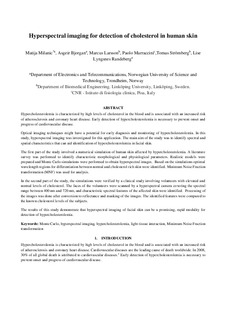| dc.contributor.author | Milanic, Matija | |
| dc.contributor.author | Bjorgan, Asgeir | |
| dc.contributor.author | Larsson, Marcus | |
| dc.contributor.author | Marraccini, Paolo | |
| dc.contributor.author | Strömberg, Tomas | |
| dc.contributor.author | Randeberg, Lise Lyngsnes | |
| dc.date.accessioned | 2015-03-13T08:05:32Z | |
| dc.date.accessioned | 2015-05-07T08:57:59Z | |
| dc.date.available | 2015-03-13T08:05:32Z | |
| dc.date.available | 2015-05-07T08:57:59Z | |
| dc.date.issued | 2015 | |
| dc.identifier.citation | Proceedings of SPIE, the International Society for Optical Engineering 2015, 9332 | nb_NO |
| dc.identifier.issn | 0277-786X | |
| dc.identifier.uri | http://hdl.handle.net/11250/283285 | |
| dc.description | Postprint | nb_NO |
| dc.description.abstract | Hypercholesterolemia is characterized by high levels of cholesterol in the blood and is associated with an increased risk of atherosclerosis and coronary heart disease. Early detection of hypercholesterolemia is necessary to prevent onset and progress of cardiovascular disease. Optical imaging techniques might have a potential for early diagnosis and monitoring of hypercholesterolemia. In this study, hyperspectral imaging was investigated for this application. The main aim of the study was to identify spectral and spatial characteristics that can aid identification of hypercholesterolemia in facial skin. The first part of the study involved a numerical simulation of human skin affected by hypercholesterolemia. A literature survey was performed to identify characteristic morphological and physiological parameters. Realistic models were prepared and Monte Carlo simulations were performed to obtain hyperspectral images. Based on the simulations optimal wavelength regions for differentiation between normal and cholesterol rich skin were identified. Minimum Noise Fraction transformation (MNF) was used for analysis. In the second part of the study, the simulations were verified by a clinical study involving volunteers with elevated and normal levels of cholesterol. The faces of the volunteers were scanned by a hyperspectral camera covering the spectral range between 400 nm and 720 nm, and characteristic spectral features of the affected skin were identified. Processing of the images was done after conversion to reflectance and masking of the images. The identified features were compared to the known cholesterol levels of the subjects. The results of this study demonstrate that hyperspectral imaging of facial skin can be a promising, rapid modality for detection of hypercholesterolemia. | nb_NO |
| dc.language.iso | eng | nb_NO |
| dc.publisher | SPIE Proceedings | nb_NO |
| dc.title | Hyperspectral imaging for detection of cholesterol in human skin | nb_NO |
| dc.type | Journal article | nb_NO |
| dc.type | Peer reviewed | en_GB |
| dc.date.updated | 2015-03-13T08:05:32Z | |
| dc.source.volume | 9332 | nb_NO |
| dc.identifier.doi | doi:10.1117/12.2076796 | |
| dc.identifier.cristin | 1231747 | |
| dc.relation.project | EU/611516 | nb_NO |
| dc.description.localcode | Copyright 2015 Society of Phot o-Optical Instrumentation Engineers. One print or electronic copy may be made for personal use only. Systematic reproduction and distribution, duplication of any materi al in this paper for a fee or for commerc ial purposes, or modification of the c ontent of the paper are prohibited. | nb_NO |
